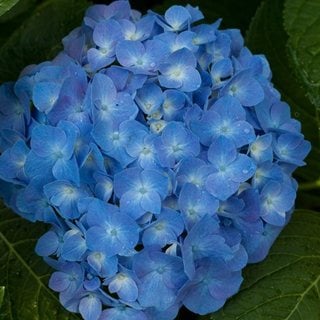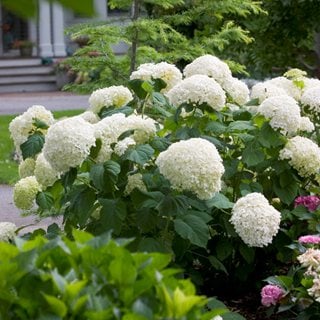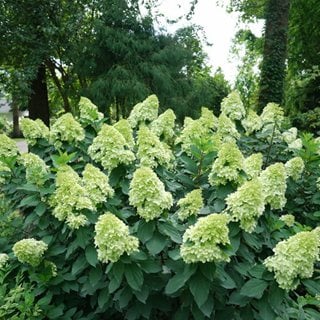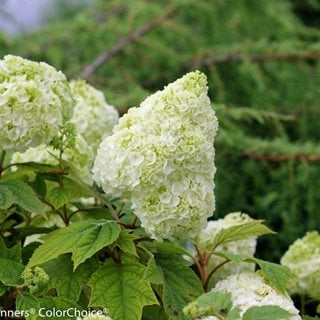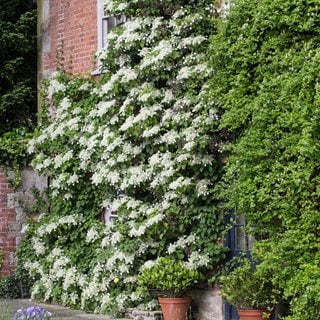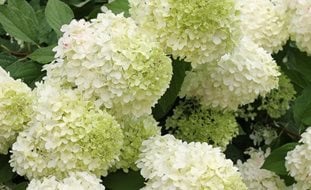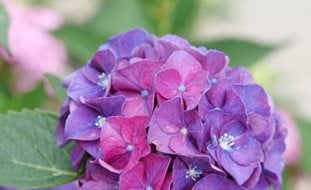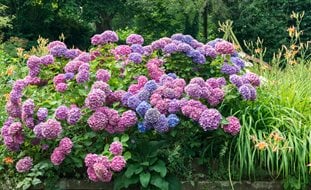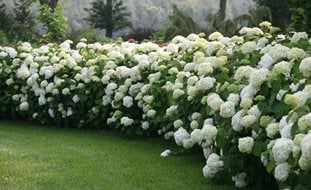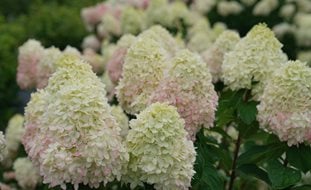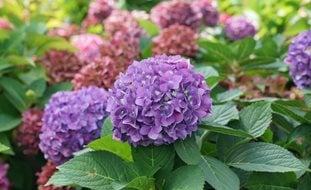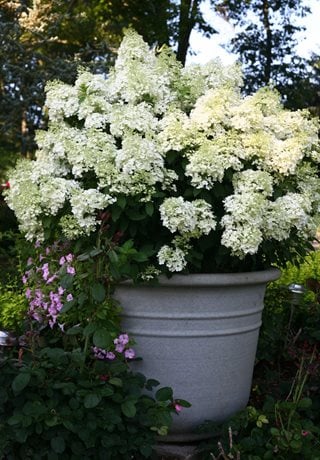Types of Hydrangeas: Key Differences & Growing Tips
Compare six common hydrangea varieties by bloom time, color, and growing needs to find the right one for your garden.Hydrangeas come in many forms, from mophead bigleaf varieties to hardy panicles and shade-loving climbers. Six main types are widely grown in U.S. gardens, each with unique blooms, growth habits, and care requirements. This page gives you a quick comparison of all six, with links to detailed guides so you can choose the best hydrangea for your space and learn how to grow it successfully.
On this page: Bigleaf | Smooth | Panicle | Oakleaf | Climbing | Mountain | Frequently Asked Questions
On this page:
- BIGLEAF HYDRANGEAS
- SMOOTH HYDRANGEAS
- PANICLE HYDRANGEAS
- OAKLEAF HYDRANGEAS
- CLIMBING HYDRANGEAS
- MOUNTAIN HYDRANGEAS
- FREQUENTLY ASKED QUESTIONS
BIGLEAF HYDRANGEAS (Hydrangea macrophylla)
Zones: 6-9, some hardy to Zones 4 or 5 with winter protection
Bloom time: June to October
Flower types: Mophead or lacecap; color shifts with soil pH (pink in alkaline soil, blue in acidic)
Size: 2 to 6 feet tall and wide (depending on variety)
Sun/Shade: Part shade, tolerates full sun in cooler climates with consistent moisture
Best for: Coastal or mild climates and gardeners who want dramatic summer color
Highlights:
- Also called French hydrangeas, mopheads or hortensias
- Newer varieties bloom on old and new wood; older cultivars bloom only on old wood
- Pruning must be timed carefully to avoid cutting off next year’s blooms (see care guide for details)
- Excellent for cut flowers and containers
- Popular selections: Let's Dance® series, Endless Summer® series, ‘Nikko Blue’, ‘Tokyo Delight’, 'Pistachio'
Learn more about growing and caring for bigleaf hydrangeas.
SMOOTH HYDRANGEAS (Hydrangea arborescens)
Zones: 3-9 (very cold hardy)
Bloom time: June to September
Flower type: Round white to pink blooms on new wood
Size: 3 to 5 feet tall and wide
Sun/Shade: Part shade; tolerates full sun in cooler climates with moist soil
Best for: Colder regions and low-maintenance summer blooms
- Native to eastern North America
- Easy to prune, often cut back hard in late winter
- Popular selections: Incrediball, Invincibelle series, ‘Annabelle’
Learn more about growing and caring for smooth hydrangeas.
PANICLE HYDRANGEAS (Hydrangea paniculata)
Zones: 3-8 (most winter hardy)
Bloom time: July to September
Flower type: Cone-shaped white blooms that may turn pink in fall
Size: 8 to 15 feet tall, 6 to 12 feet wide (dwarf varieties smaller)
Sun/Shade: Full sun to part shade
Best for: Cold climates and sunny sites needing reliable summer blooms
Highlights:
- Blooms on new wood, making pruning simple and flexible
- Prune in late winter or early spring to shape or encourage larger blooms
- Very cold-hardy and sun-tolerant compared to other types
- Popular selections: ‘Limelight’, Pinky Winky, Vanilla Strawberry, Bobo, Little Quick Fire, ‘Grandiflora’ (commonly called PeeGee)
Learn more about how to grow panicle hydrangeas.
OAKLEAF HYDRANGEAS (Hydrangea quercifolia)
Zones: 5-9
Bloom time: July to September
Flower type: White blooms that age to pink or rose; striking oak-shaped leaves with fall color
Size: 3 to 8 feet tall and wide
Sun/Shade: Full sun to part shade
Best for: Woodland gardens and four-season interest (flowers + foliage)
Highlights:
- Native to southeastern U.S.
- Blooms on old wood, so prune only after flowering if needed
- Excellent fall color; leaves turn orange, red, and burgundy
- More drought-tolerant than other hydrangeas once established
- Popular selections: Gatsby Moon®, ‘Pee Wee’, ‘Ruby Slippers’, Snowflake
Learn more about growing and caring for oakleaf hydrangeas.
CLIMBING HYDRANGEAS (Hydrangea petiolaris)
Zones: 4-8
Bloom time: May to July
Flower type: White lacecap blooms
Size: 30 to 40 feet tall, 5 to 6 feet wide (as a vine)
Sun/Shade: Part to full shade
Best for: Covering walls, fences, arbors, or shady vertical spaces
Highlights:
- Slow to establish but long-lived and vigorous once mature
- Prune lightly after flowering to control size; heavy pruning in late winter for rejuvenation
- Can also sprawl as a groundcover if unsupported
- Popular selection: ‘Miranda’
Learn more about growing and caring for climbing hydrangeas.
MOUNTAIN HYDRANGEAS (Hydrangea serrata)
Zones: 6-9
Bloom time: Early summer to fall
- Blooms on old wood; prune lightly after flowering to maintain shape
- Similar to bigleaf hydrangeas but more compact and slightly hardier
- Good for container planting and smaller spaces (See more dwarf hydrangeas.)
- Popular selections: Tuff Stuff, ‘Blue Billow’, ‘Bluebird’
Learn more about how to grow mountain hydrangeas.
FREQUENTLY ASKED QUESTIONS
Which type of hydrangea is most cold-hardy?
Panicle hydrangeas (Hydrangea paniculata) and smooth hydrangeas (H. arborescens) are the most cold-tolerant, thriving in zones as low as 3. Bigleaf and mountain types are less hardy and usually suited to zones 6–9. Proven Winners notes, "Panicle and smooth hydrangeas flower on new wood. As a result, these plants flower reliably each year no matter how cold the winter was."
Which hydrangea type changes color?
Bigleaf (H. macrophylla) and mountain (H. serrata) hydrangeas can shift from pink to blue depending on soil pH. Smooth, panicle, oakleaf, and climbing types generally do not change color. Read more on how to change hydrangea color or check out this video from Proven Winners ColorChoice Shrubs.
Which hydrangea blooms the longest?
Bigleaf and mountain hydrangeas often have the longest bloom season (June into fall), especially reblooming varieties. Panicle and oakleaf types bloom in mid to late summer; smooth hydrangeas bloom in early to mid-summer.
Which hydrangeas grow best in shade?
Climbing and oakleaf hydrangeas handle more shade than other types. Bigleaf and mountain varieties also tolerate part shade, while panicle hydrangeas prefer more sun.
Which hydrangea type is lowest maintenance?
Smooth and panicle hydrangeas are often considered easiest: they bloom on new wood and tolerate more pruning mistakes than bigleaf or mountain types, which bloom on old wood.
MORE ON HYDRANGEAS
Explore more guides on pruning, color change, and troubleshooting common hydrangea problems.

